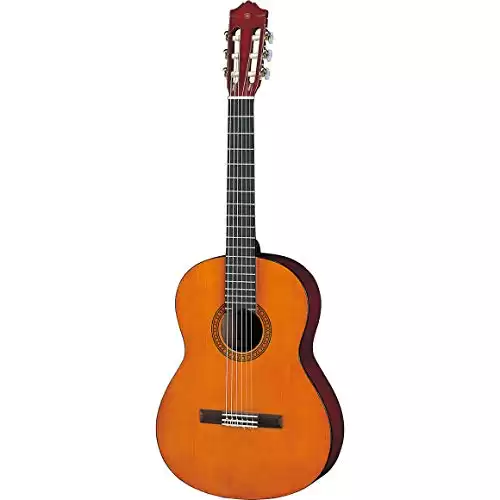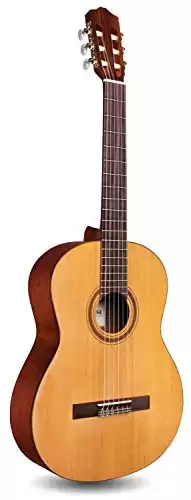Today’s classical guitar designs come from the Spanish vihuela and the gittern. Those instruments were played in the 1400s and 1500s, eventually evolving into the Baroque guitar.
Even though it had local popularity, it wasn’t until Andres Segovia popularized the instrument with early phonograph recordings and concerts that people grew to love the guitar.
What makes the classical guitar a unique instrument is the fingerstyle used to play it. With the thumb traditionally plucking the root note, the rest of the fingers are used to ring out the melody, accompanying parts, and overtones.
Smaller instruments are available to help children learn how to play the classical guitar correctly, with fret sizes reduced to accommodate smaller hands.
What Is the Most Difficult Classical Guitar Song to Play?
The most challenging song to play on the classical guitar is “Kurze Schatten II” by Brian Ferneyhough. It’s a 14-minute composition for solo guitar in the modern period that began in 1910 and ran through 1975. The note placement, speed, and unconventionality of the piece make it exceptionally difficult.
Choosing a difficult classical guitar song is subjective to the musician. What is more manageable for one person is more challenging for another.
For me, “Kurze Schatten II” tops the list because it almost plays like free jazz, even though you have a formal composition to follow.
Once you look at the sheet music for it, you’ll know it takes a lot of familiarity with string and note placement to play it successfully.
In that vein, a couple of additional extreme pieces are worth reviewing. “Toccata Orpheus” by Rolf Riehm and “away from” by Sven-David Sanstrom are also exceptionally difficult to play on the classical guitar.
Another option I’d choose is the Stele Suite. The second and fourth movements are technically complex, and I’m constantly second-guessing myself when trying to play. The fingerings are meant to be played with speed.
Other names to consider when looking for a difficult classical guitar composition include Vincent Lindsey Clark, Barrios, and The Allegro from BWV 998.
Best Classical Guitar to Buy Today
Although I’ve got a few classical guitars in my collection, the one I use the most is the Cordoba C10. This beautiful instrument offers Canadian cedar for the top with Indian rosewood for the sides and back to deliver a crisp, authentic sound with each strum.
The design includes a hand-inlaid mother-of-pearl rosette that stands out beautifully while you play. You’ll get a hardshell humidified archtop wood case with purchase to protect your investment.
It’s a concert-level instrument that plays well in virtually all conditions. It uses the traditional Spanish heel construction, which means the top of the guitar gets attached to the neck before adding the sides. The body gets sealed with the installation at the back.
It uses the Spanish fan-bracing pattern in the design, all solid woods, and a full-size experience that is an absolute joy to play.
You’ll get rich base notes, crisp trebles, and a full mid-range to appreciate. The tone and response are immaculate.
You’re going to feel like you got it for a steal. Cordoba might not be the most famous brand out there, but they’ve been producing high-quality instruments since 1997. The C10 is a solid instrument that you can take anywhere.
Best Classical Guitar for Kids
The Yamaha CGS102A Classical Guitar is an excellent choice for kids who want to learn how to play this instrument. It’s constructed with a spruce top and a Meranti body and back to replicate the crisp sounds that larger designs produce.
It comes in 1/2 and 3/4 sizes so that you can pick the right shape for current or future hand sizes. The guitar delivers brilliantly, but it does need a little time to acclimate to your environment.
Yamaha created an instrument that is comfortable to hold, stays in tune well after getting your setup complete, and doesn’t cause unnecessary fatigue in the fingers. It tends to be forgiving when you make a mistake.
Although this design is marketed for children, it also works well for seniors and others who find a full-size instrument is too big to use.
Best Classical Guitar Under $300
If you want to learn how to play the classical guitar before committing to a concert-grade instrument, it makes sense to choose an entry-level option.
I highly recommend investing in the Cordoba C3M classical guitar. It uses nylon strings that help you build calluses without the pain that comes with other options while letting you upgrade to steel when you’re ready.
You receive the traditional Spanish fan bracing, allowing the top to vibrate freely while offering the control you prefer.
It comes with a mahogany back and sides while offering a cedar top. The sound is remarkably warm and sustained for a guitar in this range. It doesn’t have a fancy inlay, but there is a wooden rosette that offers a beautiful visual.
How to Start Playing Classical Guitar Right Now
The classical guitar looks and feels like an acoustic instrument, but it has some unique qualities for musicians to consider. Each song is a rigid art form by itself, delivering numerous agreements and stipulations about how to play it correctly.
You’ll need to think about guitar placement, body position, and comfort when learning how to play this beautiful instrument.
Once you have a classical guitar to play, you can start learning how to use it by following these steps.
- Learn the notes on a classical guitar. The standard setup is E-A-D-G-B-E, although you can create alternate tunings for your compositions. This composition allows the instrument to play warmer sounds compared to other stringed instruments.
- Get to know the anatomy of the classical guitar, including the head, neck, and body. You’ll be strumming above the sound hole to produce the loudest sounds, but you can play anywhere, including at the top of the neck, to create music.
- Learn how to position your body while playing. A classical guitar is always played while sitting, which means you need a comfortable and supportive chair. Choose one without elbow rests and a firm base to achieve the best results.
- When sitting, try to position our legs to alleviate stress on the lower back. It’s traditional to place legs together for Spanish pieces while having them a shoulder-width apart for other compositions. If your legs are curved, you’ll put a lot of stress on your back.
- Adjust your left hand after sitting (or the right if you play with the left) to ensure you can reach the fretboard easily. If necessary, use a guitar support to raise the instrument height.
- Think about trimming your fingernails. Your fretting hand should have them short to have maximum string control. If you keep them longer on your picking hand, it’ll be easier to play with more volume.
- Classical guitars require you to strum them in specific ways. Your thumb always plays the E-A-D strings, which are the thickest ones at the top of the instrument. Your index finger always plays the G, the middle finger plays the B, and the ring finger plays the upper E.
- Press the strings with your thumb and other fingers simultaneously. You might be asked to pluck multiple strings simultaneously in some compositions.
- When learning the chords to play on the classical guitar, it helps to number your fingers. Although some sheet music uses standard notes, most will assign a designation to each digit to make the learning process a little easier.
- The strings have numbers when reading tabs or other sheet music. The thickest string, the lower E, is No. 6, while the upper E is No.1. If you have alternative tunings, the numbers don’t change their assignment.
- If you play an open chord, you’ll be playing a G. The next chord to learn on the classical guitar is the A. You’ll use the first three fingers of your left hand. The third finger goes on the second string at the second fret. You’ll place the second finger on the third string at the same fret. The first finger goes on the fourth string. Give the guitar a good strum.
- Next, you’ll want to learn how to play the E chord. The third finger goes on the fourth string at the second fret. Your second finger is on the fifth string at the same fret, while the first finger is on the third string at the first fret. Strum all the strings together.
How Long Does It Take to Learn How to Play the Classical Guitar?
It takes about six months to learn the basics of the classical guitar and another six months to improve personal skills. That rate occurs for musicians who practice at least five hours per week. It is possible to speed up this process with additional learning sessions during this time if rapid development is desired.
One of my first memories is sitting on the couch, listening to my mother sing “Big Bad John” by Jimmy Dean. I’m not sure when it was, but I can still picture her picking up the living room while singing along.
“Every mornin’ at the mine you could see him arrive. He stood six-foot-six and weighed 245. Kinda broad at the shoulder, and narrow at the hip, and everybody knew you didn’t give no lip to Big John.”
There’s something about the song’s rhythm that draws me to it. When I got my first classical guitar, I thought it would be a lot of fun to write a piece in the theme of Big Bad John.
That turned into the song I called “Bobcat Jones.” It was destined to be the song my mother grew to hate after less than a week of practice.
Although I never recorded the song, I did play it in public once. In college, I was asked to prepare a presentation that talked about what I’d learned in music, so I thought it would be an appropriate way to show educational evolution. Here was my first song, and then here’s the one I’m working on right now.
I think it’s essential to embrace music early. When we grow to love it as kids, the melodies and songs shape who we are.
If you throw a classical guitar into the mix to help create your own compositions, it reinforces the value of this auditory art.





